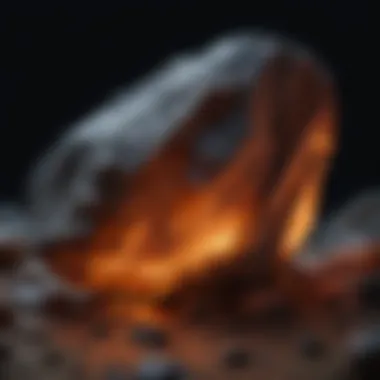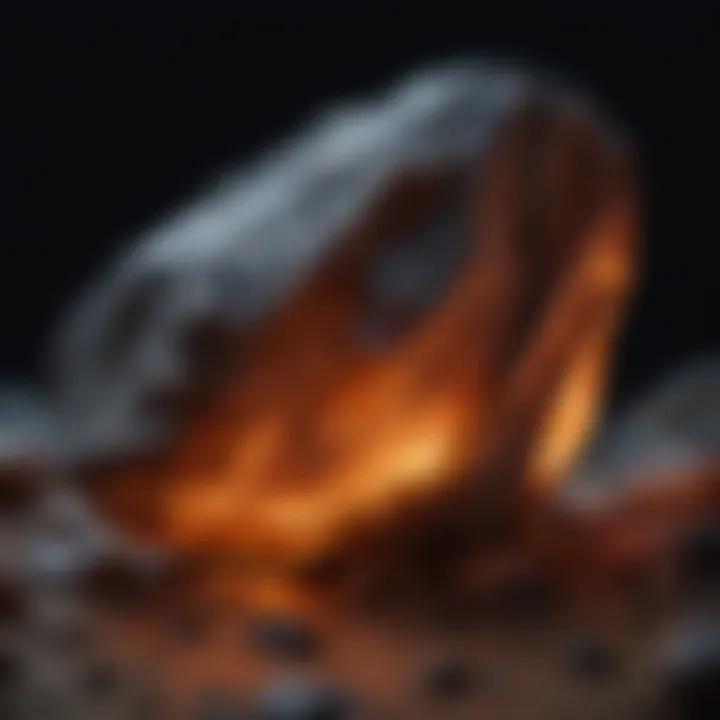The Comprehensive Guide to Glow Rocks: Science and Collectibility


Intro
In recent years, glow rocks have captivated the interest of both casual enthusiasts and dedicated collectors. Understanding these unique geological specimens requires a dive into their science and collectibility. This guide will explore the origins, types, and care recommendations for glow rocks, making it a valuable resource for anyone intrigued by these luminous wonders.
History and Origins
Overview of Collectibles, Rocks, and Fossils
The allure of collectibles spans centuries, incorporating items from coins to rare stamps, and, more prominently, rocks and fossils. Rocks that exhibit luminescent properties, known as glow rocks, are a niche yet compelling category within this broader collectible market. Ancient humanity often regarded minerals with unusual features as enchanted or possessing special powers, leading to their meticulous collection. As scientific understanding evolved, glow rocks transitioned from mystical artifacts to objects of serious study.
Historical Significance and Cultural Impact
Across various cultures, glow rocks represented more than mere geological conundrums. For instance, in some Native American tribes, certain luminous minerals held significant spiritual meanings. In the late 19th and early 20th centuries, the advent of modern science opened new realms of inquiry, allowing researchers to examine the properties and applications of these rocks. The involvement of scientists, such as Marie Curie, in radioactivity, directly influenced the interest in luminescent materials, expanding their reach beyond folklore into laboratories and classrooms. Thus, the historical narrative of glow rocks is intertwined with the pursuit of knowledge and discovery.
Identification and Classification
Guide to Identifying Rocks and Fossils
Identifying glow rocks hinges on understanding their luminescence. Common identification techniques involve:
- Visual inspection: Observing the glow under UV light.
- Physical properties: Examining texture and hardness.
- Geochemical tests: Analyzing mineral composition to confirm characteristics.
These methods aid in distinguishing glow rocks from regular specimens, ensuring collectors can accurately assess their find.
Common Types and Variations
Various types of glow rocks exist, each featuring unique properties. Common variations include:
- Fluorescent rocks: Emit light when exposed to UV light, such as calcite or fluorite.
- Phosphorescent rocks: Store energy from light and release it gradually, often seen in strontium aluminate.
- Radioactive glow rocks: These can emit light due to radioactive decay, like certain uraninite specimens.
By learning to identify these categories, collectors can refine their collections and deepen their understanding of geological phenomena.
"The beauty of glow rocks lies not just in their appearance but in the stories they tell through science and history."
Preamble to Glow Rocks
The study of glow rocks offers fascinating intersections between geology, science, and collectibility. Understanding what glow rocks are and how they form opens avenues to appreciate both their natural beauty and their scientific significance. The allure of glow rocks lies not only in their unique visual properties but also in their properties and the processes that create them. Collectors and enthusiasts are drawn to their aesthetic qualities, as well as the stories and science behind their luminescence. This section is vital for setting the groundwork for readers to explore further last sections of the article.
What Are Glow Rocks?
Glow rocks are natural mineral specimens known for their ability to emit light under certain conditions. This luminescent phenomenon can occur through various mechanisms, including fluorescence, phosphorescence, and triboluminescence. Each type of glow rock exhibits a unique glow based on its mineral composition and the environmental conditions it encounters.
The glow often manifests in striking colors, depending on the materials present. Common types of glow rocks include those containing minerals such as calcite, willemite, or fluorite, which are prized by collectors for their eye-catching displays. Glow rocks not only represent geological diversity but also scientific intrigue, making them valuable both for study and collection.
The Science Behind Luminescence
The science of luminescence is rooted in the interaction between minerals and external energy sources. Luminescence occurs when energy from various sources—such as ultraviolet light or pressure—is absorbed and re-emitted as light. There are three primary types of luminescence relevant to glow rocks:
- Fluorescence: This occurs when a mineral absorbs ultraviolet light and re-emits visible light almost instantaneously. This process stops as soon as the energy source is removed.
- Phosphorescence: In contrast to fluorescence, phosphorescent minerals can store absorbed energy and slowly release it over time, creating a prolonged glow even after the light source has been removed.
- Triboluminescence: This refers to the light produced when a mineral is mechanically agitated, such as by scratching or crushing the material.
Understanding these scientific principles not only deepens appreciation for glow rocks but also aids collectors in their identification and valuation.
"The allure of glow rocks transcends mere aesthetics; they bridge the gap between beauty and science, captivating both collectors and scholars alike."
Geological Formation of Glow Rocks
Understanding the geological formation of glow rocks is essential for comprehending their unique properties and characteristics. This section explores how different minerals come together to create these captivating rocks and the processes by which they form. Each glow rock tells a story of its origins, influenced by the Earth’s geological activity. Collectors and enthusiasts gain valuable insight into the significance of these formations, which enhances their appreciation as well as their collecting experience.
Mineral Composition
The allure of glow rocks is rooted in their mineral composition. Different minerals exhibit luminescent properties, which allow them to glow under certain conditions. Common minerals found in glow rocks include:


- Fluorite: Known for its vivid fluorescing colors when exposed to ultraviolet light.
- Calcite: Can exhibit both fluorescence and phosphorescence, making it a versatile specimen.
- Willemite: This mineral glows green under shortwave ultraviolet light, creating a striking visual effect.
- Scheelite: Recognized for its blue glow, particularly under ultraviolet illumination.
Each mineral’s composition plays a crucial role in its luminescent properties. Understanding the specific elements can inform collectors about the rock's behavior under various light sources. This knowledge enhances identification skills, enabling collectors to distinguish between similar-looking specimens.
Formation Processes
Glow rocks undergo particular geological processes that give rise to their luminescent features. These processes can vary significantly, depending on environmental conditions and mineral presence. Key formation processes include:
- Igneous Processes: Some glow rocks form from molten rock materials. As these materials cool, minerals crystallize, capturing elements conducive to luminescence.
- Metamorphic Processes: Heat and pressure can alter existing rocks, changing their mineral composition. This alteration can lead to enhanced luminescent properties in certain minerals.
- Sedimentary Processes: In some cases, glow rocks may form from sediment accumulation. Minerals contained within sediments can develop luminescent qualities over time, particularly in rich geological settings.
"Geological processes determine not just the appearance but also the intrinsic value of glow rocks, bridging the gap between natural history and scientific curiosity."
Understanding these processes not only informs collectors about the origins of their specimens but also assists in appreciating the intricate connections between geology and luminescence. Moreover, knowledge of formation helps guide collectors in locating new specimens, thus expanding their collections.
Types of Glow Rocks
Understanding the different types of glow rocks is essential for collectors and enthusiasts alike. Each category showcases unique characteristics. These varieties offer not only scientific insights but also significant collectibility aspects. Collectors should identify which type they are interested in, as it can influence purchasing decisions and collecting strategies.
Fluorescent Rocks
Fluorescent rocks are quite intriguing. They glow under ultraviolet light. This glow occurs almost instantaneously when exposed to UV radiation. Common minerals exhibiting fluorescence include calcite, fluorite, and willemite.
Fluorescent rocks are popular among collectors because their glow can be spectacular, revealing vibrant colors not visible under normal light. However, it's crucial to store them properly to prevent damage. Avoid prolonged exposure to sunlight, as this can diminish their luminescent properties.
These rocks can be found in various locations around the world. For example, the fluorescent minerals from Franklin, New Jersey, are particularly renowned. The vibrant hues and the science behind how they glow create a level of fascination.
Phosphorescent Rocks
Phosphorescent rocks have the ability to store energy from light. This energy is then released slowly, allowing them to continue to glow for a period of time, even after the light source is removed. Common examples include baryte and some types of strontium minerals.
For collectors, owning phosphorescent rocks means having specimens that can continue to captivate after the lights go out. The duration of the glow can vary, with some specimens glowing for moments, while others might last for hours. This extended glow time enhances their appeal. Proper care aids in preserving their luminescent abilities.
"Phosphorescent rocks create a magical sight, especially in dim environments where their glow can fully be appreciated."
Triboluminescent Rocks
Triboluminescent rocks exhibit a unique form of luminescence caused by mechanical action. When these rocks are struck, scratched, or otherwise manipulated, they emit light. Common minerals that showcase this property include quartz and certain types of calcite.
This type of luminescence can be less predictable than fluorescent or phosphorescent properties. It's reliant on physical stress, making every occurrence potentially different for collectors. Consequently, rocks that demonstrate this quality can be quite rare and valuable.
Collectors might experiment with different methods to activate the glow, but care must be taken to avoid damaging the specimens. The hands-on nature of triboluminescence can provide an engaging and educational experience.
In summary, each type of glow rock enriches the collector's experience and contributes to a deeper understanding of geological processes. Their unique properties and the science behind them enhance their collectibility, making them valued pieces in any collection.
Identifying Glow Rocks
Identifying glow rocks is a crucial aspect for both collectors and enthusiasts. Understanding how to correctly identify these unique geological specimens enhances appreciation and adds value to any collection. Glow rocks exhibit specific characteristics that set them apart from standard minerals. Knowledge of their identification helps prevent purchasing misrepresented items, ensuring that both novice and experienced collectors invest wisely.
Visual Characteristics
When it comes to visual characteristics, several key features distinguish glow rocks. These rocks often have distinct appearances that can be identified even before any luminescent properties are tested.
- Coloration: Glow rocks may present a range of colors, influenced by their mineral composition. Some may appear dull in daylight but reveal vibrant hues under ultraviolet (UV) light.
- Texture: The surface texture of glow rocks can vary. They may be smooth, rough, or even have a crystalline structure. These textures contribute to their classification.
- Inclusions: Many glow rocks contain inclusions, which can impact their glow. Tiny mineral specks or other materials embedded within a rock can suggest specific origins or types of luminescence.
For correct identification, it is essential to keep in mind that not all luminescent stones are glow rocks. Therefore, close examination of their visual characteristics is key to making an accurate identification.
Testing for Luminescence
Testing for luminescence is the definitive method to confirm whether a rock is indeed a glow rock. There are three principal types of luminescence to consider: fluorescence, phosphorescence, and triboluminescence. Each requires specific testing methods:
- Fluorescence Testing: This can be done simply using a UV light. Shine the light on the rock and observe the glow. Some minerals, such as fluorite and calcite, showcase vivid fluorescence under UV rays while remaining unlit in standard conditions.
- Phosphorescence Testing: To test for phosphorescence, observe how the rock behaves after the UV light is removed. If the rock continues to emit light for a few seconds, it likely possesses phosphorescent qualities. A classic example includes zinc sulfide.
- Triboluminescence Testing: This can be more hands-on, as it requires physically breaking or rubbing the rock. If it emits light upon friction or stress, it demonstrates triboluminescence. An example of such a rock is quartz.


Identifying glow rocks through visual observation and luminescence testing opens doors to understanding their unique properties and origins.
Mastering these identification techniques can lead to more informed collecting practices. For the serious collector, combining visual characteristics and luminescence testing will provide an enhanced understanding and appreciation of glow rocks.
Collectibility and Value of Glow Rocks
The sphere of glow rocks extends beyond mere natural wonders; it intertwines with the intricate tapestry of collecting and valuation. Understanding the factors that influence their collectibility unveils a mix of science, art, and market dynamics that serve to enhance their appeal. Glow rocks attract not only enthusiasts but also investors who recognize their potential value appreciation over time. Collecting these ethereal artifacts must include a deeper understanding of their significance and market behavior.
Market Trends
Glow rocks have seen an evolution in market trends over the years. Interest in natural specimens has surged, leading to increased demand among collectors. This demand is often driven by several factors:
- Increased Awareness: The advent of social media platforms like Facebook and Reddit has fostered communities around glow rocks. These platforms allow collectors to share their finds, thus drawing attention to the beauty of luminescent minerals.
- Rarity and Discovery: As new locations for glow rock discoveries emerge, collectors seek those rare pieces that not only glow but also carry a story or geographic uniqueness. This trend amplifies the excitement around finding and obtaining such specimens.
- Auction and Sales Platforms: Specialized auction sites and online marketplaces like eBay provide avenues for buying and selling glow rocks, increasing their visibility and generating competitive pricing. Thus, the interconnectivity of these platforms plays a pivotal role in shaping the collector landscape.
Factors Influencing Value
The value of glow rocks hinges on various elements that discerning collectors must assess:
- Rarity: Limited availability directly correlates with value. Rare specimens tend to be more desirable, leading to higher price tags.
- Quality of Luminescence: The intensity and duration of the glow impact a rock's desirability. The brighter and longer the glow, the more valuable the specimen.
- Condition and Preservation: Well-preserved specimens command higher prices. Signs of wear or environmental damage can significantly reduce value.
- Provenance: A well-documented history or a notable previous owner can enhance a rock's value. Collectors often place a premium on pieces with rich backgrounds.
- Market Demand: Current trends in geoscience and mineralogy can shift collector interests, impacting pricing. As scientific understanding evolves, so too does the perceived worth of certain luminescent minerals.
Understanding these aspects can provide collectors with the insight needed to make informed decisions. For anyone serious about investing in glow rocks, keeping abreast of market trends and factors influencing value is essential.
"The collectibility of glow rocks merges beauty with investment potential, appealing to collectors and investors alike."
Determining the collectibility and value of glow rocks is not just a matter of aesthetics; it requires a multifaceted approach that considers market dynamics, specimen attributes, and collector interests.
Caring for Your Glow Rock Collection
Caring for a glow rock collection is vital for maintaining the beauty and integrity of these unique specimens. Glow rocks, with their luminescent properties, can be a fascinating addition to any collection. However, they require specific handling to preserve their qualities over time. Proper care aids in preventing damage, such as fading or degradation, which can significantly diminish both their aesthetic appeal and scientific value. By implementing effective storage and cleaning techniques, collectors can ensure that their glow rocks remain vibrant for many years.
Storage Solutions
Finding the right storage for glow rocks is essential to prevent chips, scratches, or exposure to damaging elements. Here are some important considerations:
- Use of Display Cases: A well-constructed display case with proper padding can protect your glow rocks from environmental factors. Look for a case with UV protection to minimize light exposure, which can affect luminescence.
- Environment Control: Maintaining a stable temperature and humidity level can prevent moisture buildup, which may lead to mold growth or mineral expansion.
- Separation from Other Minerals: It’s essential to store glow rocks away from harder minerals that might scratch them. Individual compartments within the storage solution are ideal for avoiding any contact during handling.
If you want your glow rocks to shine, treat them like the treasures they are.
Another useful tip is to avoid stacking multiple rocks on top of each other. This approach may seem space-efficient but could lead to cracks or fractures. Instead, position each piece so that it has some space around it.
Cleaning Techniques
To maintain the clarity and brightness of glow rocks, cleaning must be approached with caution. Here are some effective techniques:
- Gentle Wiping: Use a soft, lint-free cloth to gently wipe the surface of the stones. This approach removes dust without scratching the surface.
- Avoid Harsh Chemicals: Many cleaners contain abrasive ingredients that can damage a glow rock’s surface. Instead, opt for a mild soap solution and water for a more suitable cleaning method.
- Rinsing Carefully: After cleaning the rocks, ensure to rinse them with distilled water to avoid mineral deposits that tap water can leave behind.
- Air Drying: Allow the glow rocks to air dry fully before placing them back into storage. This step prevents moisture entrapment, which could harm the rock’s integrity over time.
Keeping your collection in top shape should be a priority for any serious enthusiast. Proper storage and careful cleaning will enhance the long-term enjoyment and scientific value of your glow rocks.
The Role of Glow Rocks in Education
The study of glow rocks offers a unique opportunity to engage learners in the field of geology. These rocks not only captivate students with their luminescent properties, but also serve as valuable educational tools. The incorporation of glow rocks into educational settings can enhance understanding of mineralogy, luminescence, and geological processes. They can be used in classrooms and field studies to illustrate complex scientific principles in an accessible manner.
Teaching Geology Concepts
Glow rocks provide a tangible way to teach fundamental geology concepts. For example, educators can explain the processes of mineral formation and the science behind luminescence using these materials as examples. When discussing the mineral composition of rocks, educators can highlight how specific minerals like calcite or fluorite contribute to luminescent properties. This practical approach reinforces theoretical knowledge with visual aids and direct observation.
Moreover, lessons can be tailored to explore topics such as sedimentary layers, igneous processes, and metamorphic changes while using glow rocks as case studies. This method can stimulate curiosity and foster a deeper understanding of Earth's geological history.
Hands-on Learning Opportunities
Hands-on learning is vital for effective education, particularly in science. Glow rocks can be a key component of interactive learning experiences. Students can engage in activities such as:


- Identifying different types of glow rocks: This helps develop skills in observation and classification.
- Conducting experiments: Students can test luminescence through various techniques, such as exposing the rocks to UV light.
- Field trips to significant locations: Collecting glow rocks from natural sites can build a connection between theoretical knowledge and real-world applications.
Engaging directly with these materials not only enhances retention but also instills a sense of wonder into scientific exploration.
These activities enrich the educational experience and help students appreciate the complexities and beauty of geology. By using glow rocks, educators pave the way for future rock and fossil collectors, encouraging a lifelong interest in geology and natural sciences.
Notable Locations for Glow Rocks
Understanding notable locations for glow rocks is crucial for both collectors and enthusiasts. These sites offer a unique glimpse into the geological processes that produce these fascinating minerals. They provide opportunities for fieldwork, exploration, and expanding one's collection. Here's a closer look at some significant geological sites and practical tips for local collecting.
Significant Geological Sites
Various places around the globe are known for their glow rocks. Each site has specific characteristics that contribute to the luminescent properties of the rocks found there. Below are several noteworthy locations:
- The Appalachian Mountains: This region features a range of mineral deposits, including fluorescent minerals like fluorite and calcite. These minerals can exhibit brilliant colors under ultraviolet light.
- The Rocky Mountains: Known for diverse geology, areas within the Rockies showcase phosphorescent minerals that thrill collectors and researchers alike.
- The caves of the South Pacific: Certain caves in this region contain triboluminescent minerals that can exhibit glow when the rocks are struck or manipulated. These caves provide a unique environment for exploration.
- The Sierra Nevada: This mountain range has been known for its dazzling collections of glow rocks, especially in certain quarries or old mining sites where unique minerals are still present.
These geological sites are not just visually captivating; they also hold significant scientific value. Understanding their formation, location, and mineral composition can lead to better knowledge of how glow rocks are created.
Local Collecting Tips
When collecting glow rocks from local sites, consider the following practical tips for a successful experience:
- Research Regulations: Before heading out, always check any collecting regulations in the area. Some places may have rules that limit or forbid collecting.
- Bring Proper Equipment: Always have the right tools. A geologist's hammer, chisel, and safety goggles will help you safely extract samples.
- Use UV Light: Carry a portable ultraviolet light to test the rocks on-site. This will help confirm whether the rocks display luminescent properties.
- Document Your Finds: Keeping a collecting journal with photos and notes about each location will enhance your understanding and appreciation of your collection.
- Network with Local Collectors: Engaging with local rock and mineral clubs can provide valuable information about the best spots for collecting.
Local knowledge can be invaluable. Connecting with residents or collectors in the area often leads to discovering hidden gems that guidebooks may overlook.
In summary, notable locations for glow rocks offer both practical collecting opportunities and deeper geological insights. By understanding these sites and practicing responsible collecting, rock enthusiasts can significantly enhance their knowledge and collections.
The Future of Glow Rocks in Collecting
The realm of glow rocks holds both a rich history and a promising future. As the interest in unique geological specimens grows, the significance of glow rocks in the collecting community becomes more pronounced. This section aims to explore emerging trends and the ethical considerations tied to the collecting of glow rocks.
Emerging Trends
The market for glow rocks is witnessing shifts influenced by several factors. One key trend is the increase in online communities dedicated to rock and mineral collecting. Platforms like Reddit and Facebook are fostering interactions among enthusiasts, encouraging sharing of knowledge and specimens. This surge in online interest has led to heightened demand and prices for rare specimens, particularly those that exhibit extraordinary luminescent properties.
Furthermore, educational institutions are recognizing the value of glow rocks in teaching geology and natural history. Workshops and courses that incorporate hands-on exploration of luminescent minerals are gaining popularity among schools and universities. Such initiatives not only cultivate interest among students but also expand the potential collector base.
Another trend is the rise of technology in identification and authenticity verification of glow rocks. Apps and tools that allow users to analyze their collections are becoming more accessible. These advancements can enhance the collecting experience by aiding collectors in understanding the provenance and characteristics of their specimens.
"The rise in technology for identification may ultimately enrich the collector's experience, bringing further depth to the lore surrounding glow rocks."
Sustainability and Ethics
As the popularity of glow rocks grows, the discussion around sustainability and ethics in collecting is increasingly relevant. Many collectors are beginning to consider the impact of their collecting habits on natural environments. Over-harvesting of particular sites can lead to ecological degradation and loss of crucial geological features.
Ethical collecting practices involve obtaining specimens responsibly. This means sourcing rocks from locations where collection is permitted and done sustainably. Many collectors advocate for purchasing from reputable dealers who follow ethical guidelines, ensuring that their acquisitions do not contribute to environmental harm.
Moreover, local laws governing the collection of minerals should always be respected. Understanding the legal framework surrounding glow rock collection not only protects the collector but also preserves the integrity of local ecosystems. Specifically, collectors should prioritize educating themselves about indigenous practices and sites, recognizing their significance in cultural contexts.
Educators emphasize the importance of stewardship, encouraging collectors to participate in conservation efforts. Initiatives that promote sustainable practices can lead to a healthier environment and maintain the allure of glow rocks for future generations.
End
The conclusion serves as a pivotal part of this article on glow rocks, encapsulating the essence of the complexities and wonders associated with these natural specimens. It highlights the intersection of science, geology, and collectibility. By summarizing the key points, it reinforces the significance of glow rocks not only as fascinating objects of study but also as collectibles that capture the imagination of enthusiasts.
Summation of Key Points
This article explored various facets of glow rocks:
- Definition and Properties: Glow rocks exhibit unique luminescent properties, primarily defined by the types of luminescence they possess, namely fluorescence, phosphorescence, and triboluminescence.
- Geological Formation: Understanding the mineral composition and formation processes is essential for comprehending their origin and overall geological significance.
- Types and Identification: Identifying different types of glow rocks involves understanding their visual characteristics and applying various testing methods to confirm their luminescence.
- Collectibility: Market dynamics affecting the collectibility of these rocks were discussed, including trends and factors influencing their value.
- Care and Maintenance: Best practices for maintaining a glow rock collection were outlined, ensuring that these beautiful specimens remain in pristine condition.
- Educational Importance: The role of glow rocks in educational settings can motivate students to explore geology in interactive ways.
- Future Prospects: The discussion on emerging trends related to sustainability and ethics opens avenues for responsible collecting.
This summation serves as a reminder to both scholars and collectors of the intricate relationship between nature and the curiosity it inspires.
Encouraging Future Exploration
As the exploration into the world of glow rocks continues, future researchers and collectors are encouraged to delve deeper into this niche field.
The scientific community and hobbyists can benefit from new methods of investigation, better understanding the conditions that lead to the formation of these luminescent stones.
Engaging with communities through platforms like Reddit or forums dedicated to geology can foster exchange of ideas and findings.
Participation in field trips to significant geological sites enhances both knowledge and experience.
Also, sustainable practices in collecting should remain a priority. Advocating for ethical collection and awareness of environmental impact can help preserve these geological treasures for future generations.
Ultimately, the continued interest in glow rocks will not only enrich personal collections but also contribute to a broader understanding of geological phenomena and the delicate balance of our ecosystems.



